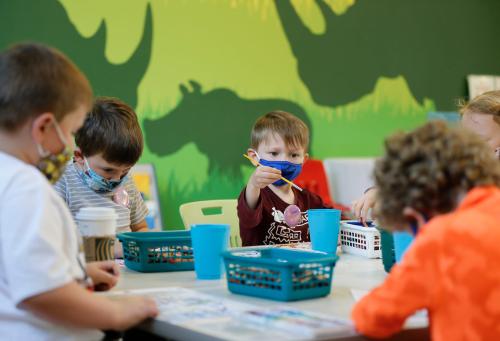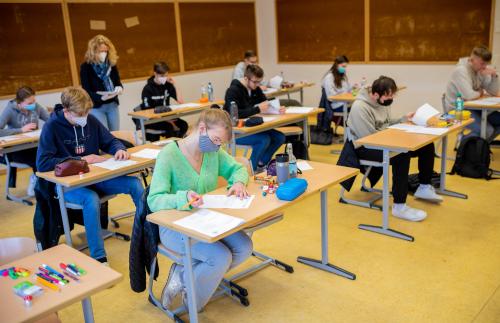With the largest-ever federal investment in education, hundreds of billions of dollars are flowing to states and school districts under the American Rescue Act. The call is for states to use this money for innovation across a broad set of priorities. As schools and school districts consider students’ needs and how to allocate resources, data are critical to the decision-making process.
In February, the federal government mandated that state testing resume during the spring of 2021. This emphasis reflected a view of data as an important piece of the education recovery effort and created the opportunity to collect information on students after a substantial gap in testing practices. As states were encouraged to think of the data formatively–for guiding planning and instructional solutions, rather than for assessing accountability and performance–the results are expected to play a large role in shaping the design of education recovery programs, innovations, and priorities at the state and local levels, impacting students for many years to come.
Though state-mandated testing provides important information on students’ learning needs, it’s not required to begin until third grade, leaving a dearth of information on the youngest students in public schools. As we begin to utilize spring 2021 state data, we must ensure that a lack of standardized data on students younger than third grade does not result in a lack of attention to these young learners. Investing in them is essential to long-term, sustained educational recovery.
New Data from Virginia on the Youngest Learners
Testing of young students is not a standardized practice nationally. However, assessments across K-2 (to include kindergarten entry assessments and/or universal screening practices, particularly for reading) are legislatively required in at least 35 states. Data from these assessments can help states motivate a focus on young learners and provide information relevant to their local context. This may be particularly important given that few independently conducted national studies have focused on young learners (see here for an exception).
Some colleagues and I recently released a report on Virginia’s legislatively mandated assessments of early reading. It offers a sobering picture of young learners. Data collected in the fall of 2020 represent over 90% of kindergarten and first-grade students enrolled in public school across 131 of 132 Virginia’s school divisions. The sample of over 130,000 kindergarten and first-grade students (across almost 1,000 schools) is comparable, demographically, to statewide student populations in recent years.
Findings from the fall of 2020 demonstrate that over one-quarter of kindergarten and first-grade students were considerably behind in early literacy skills at the beginning of the 2020-2021 school year (based on the Phonological Awareness Literacy Screener, or PALS). This is 10 percentage points higher than any other time in the 20-year history of this early reading assessment. It translates to 11,000 more kindergarten and first-grade students considered at-risk for future reading difficulties in fall 2020 compared to fall 2019. (Figure 1 below compares 2019 and 2020 data separately for kindergarten and first-grade students).
Disaggregating the data by student subgroups, as done in Figure 2 below, reveals two key patterns that are both of concern. (Patterns are shown for kindergarten but are similar in first grade.) Looking across student subgroups, the percent of students at-risk in early reading development in 2020 varies significantly across student demographic characteristics. In fact, approximately 30%-50% of students identified as Black, Hispanic, economically disadvantaged, and as an English learner entered school in the fall of 2020 significantly behind in early reading (compared to 21% of students identified as white). Looking within each student subgroup, changes from fall 2019 to fall 2020 show drops in early reading development for all student subgroups (seen in Figure 2 as increased levels of students with reading difficulties). Collectively, the data show existing and systemic inequities becoming more entrenched in the fall of 2020, and that all students’ reading is worse in the fall of 2020 than in the fall of 2019.
Adopting a Prevention Lens to Support Reading Skills
Inequitable patterns in academic achievement take root in children’s early years. Research shows that 90% of children struggling with basic reading at the end of first grade continue to struggle in third grade and beyond. Third-grade reading failure, in turn, equates to a four-to-six-fold increase in the risk of dropping out of high school, depending upon other risk factors. However, there’s also reason to believe that intervening during this period can be especially worthwhile.
Decades of research on addressing reading difficulties in young learners are applicable to the current educational recovery efforts. Recently referred to as the science of reading, this research emphasizes the need to build foundational reading skills through systematic and explicit techniques that serve all children, but particularly those who are vulnerable in reading development. A recent report by the Council of Chief State School Officers describes how states can apply the science of reading to the current context. It highlights the importance of using evidence-based strategies that have been effective in addressing gaps in reading skill development and are applicable for accelerating learning in response to the lost or altered educational opportunities of the past 15 months. These interventions add both time and systematic focus to classroom learning in ways that are individualized to students’ needs. As such, they must build upon a strong instructional base in the classroom that places a dual emphasis on building basic reading skills and broadening higher-order language skills, vocabulary, and relevant areas of content knowledge.
As states begin to focus on the results from spring 2021 testing to guide investments and innovations that will prompt an educational recovery, it is important to bring visibility and support to the youngest learners. Data from kindergarten entry assessments and/or universal screening measures in K-2 offer educators actionable information at a point when children’s learning trajectories can be significantly altered through instructional interventions. Ensuring that these data are intentionally sought out and included in recovery planning and programming will help ensure that short-term investments in educational solutions address current challenges and prevent future problems.
The Brookings Institution is committed to quality, independence, and impact.
We are supported by a diverse array of funders. In line with our values and policies, each Brookings publication represents the sole views of its author(s).










